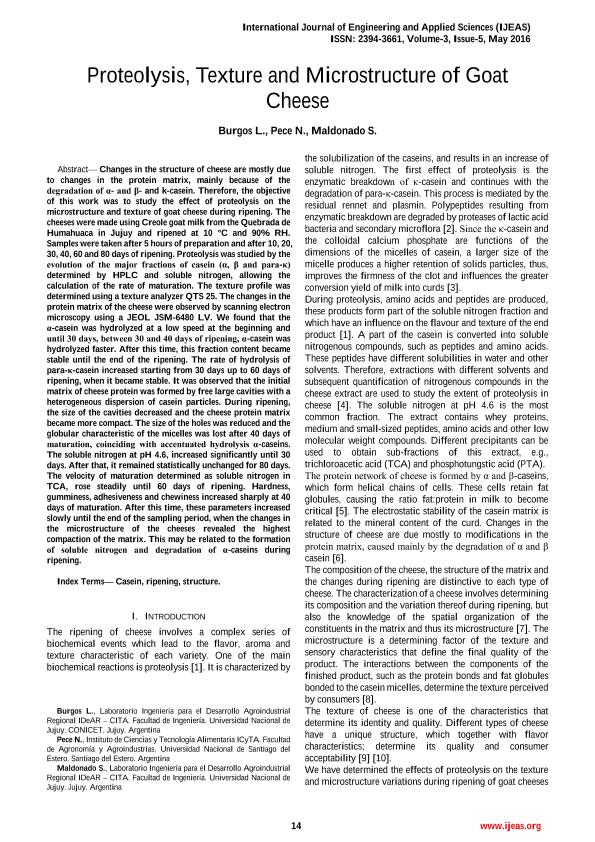Artículo
Proteolysis, Texture and Microstructure of Goat Cheese
Fecha de publicación:
05/2016
Editorial:
Jaipur: international Journal of Engineering and Applied Sciences
Revista:
International Journal of Engineering and Applied Sciences
ISSN:
2394-3661
Idioma:
Inglés
Tipo de recurso:
Artículo publicado
Clasificación temática:
Resumen
Changes in the structure of cheese are mostly due to changes in the protein matrix, mainly because of the degradation of α- and β- and k-casein. Therefore, the objective of this work was to study the effect of proteolysis on the microstructure and texture of goat cheese during ripening. The cheeses were made using Creole goat milk from the Quebrada de Humahuaca in Jujuy and ripened at 10 °C and 90% RH. Samples were taken after 5 hours of preparation and after 10, 20, 30, 40, 60 and 80 days of ripening. Proteolysis was studied by the evolution of the major fractions of casein (α, β and para-κ) determined by HPLC and soluble nitrogen, allowing the calculation of the rate of maturation. The texture profile was determined using a texture analyzer QTS 25. The changes in the protein matrix of the cheese were observed by scanning electron microscopy using a JEOL JSM-6480 LV. We found that the α-casein was hydrolyzed at a low speed at the beginning and until 30 days, between 30 and 40 days of ripening, α-casein was hydrolyzed faster. After this time, this fraction content became stable until the end of the ripening. The rate of hydrolysis of para-κ-casein increased starting from 30 days up to 60 days of ripening, when it became stable. It was observed that the initial matrix of cheese protein was formed by free large cavities with a heterogeneous dispersion of casein particles. During ripening, the size of the cavities decreased and the cheese protein matrix became more compact. The size of the holes was reduced and the globular characteristic of the micelles was lost after 40 days of maturation, coinciding with accentuated hydrolysis α-caseins. The soluble nitrogen at pH 4.6, increased significantly until 30 days. After that, it remained statistically unchanged for 80 days. The velocity of maturation determined as soluble nitrogen in TCA, rose steadily until 60 days of ripening. Hardness, gumminess, adhesiveness and chewiness increased sharply at 40 days of maturation. After this time, these parameters increased slowly until the end of the sampling period, when the changes in the microstructure of the cheeses revealed the highest compaction of the matrix. This may be related to the formation of soluble nitrogen and degradation of α-caseins during ripening
Palabras clave:
Proteolysis
,
Goat Cheese
,
Texture and Microstructure
Archivos asociados
Licencia
Identificadores
Colecciones
Articulos(SEDE CENTRAL)
Articulos de SEDE CENTRAL
Articulos de SEDE CENTRAL
Citación
Burgos, Laura Silvina; Pece Azar, Nora Beatriz del Carmen; Maldonado, S.; Proteolysis, Texture and Microstructure of Goat Cheese; Jaipur: international Journal of Engineering and Applied Sciences; International Journal of Engineering and Applied Sciences; 3; 5; 5-2016; 14-19
Compartir




